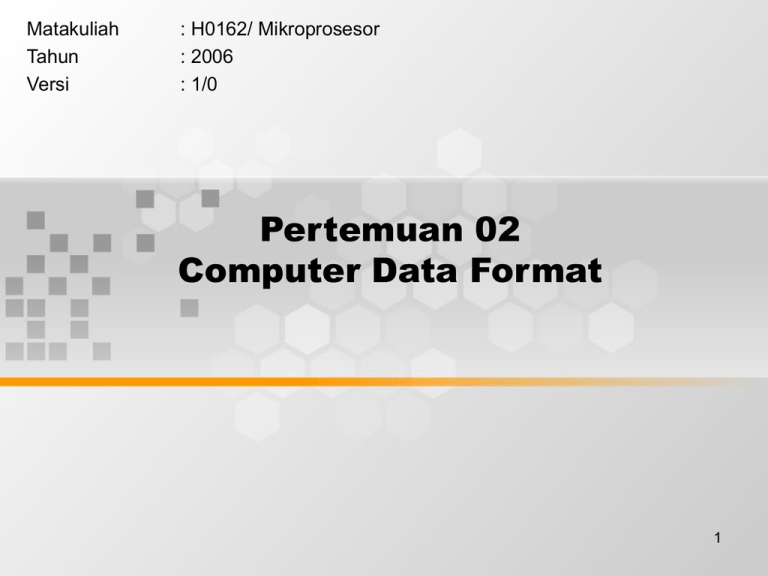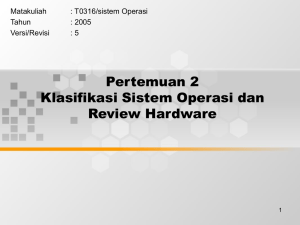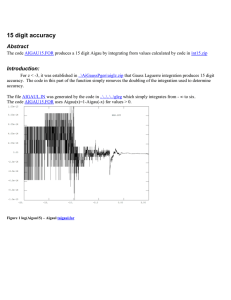Pertemuan 02 Computer Data Format Matakuliah : H0162/ Mikroprosesor
advertisement

Matakuliah Tahun Versi : H0162/ Mikroprosesor : 2006 : 1/0 Pertemuan 02 Computer Data Format 1 Learning Outcomes Pada akhir pertemuan ini, diharapkan Mahasiswa dapat mendemonstrasikan kemampuan: • mengkonversikan antar sistem bilangan (C3) 2 Outline Materi • Sistem Bilangan • Konversi antar Sistem Bilangan • Format Data 3 4 Sistem Bilangan Desimal dan Biner 5 Sistem Bilangan 6 Biner • Sistem bilangan Biner mengggunakan hanya dua simbol yaitu 0 dan 1, walau demikian, sistem basis 2 ini dapat digunakan untuk mewakilkan jumlah berapapun yang dapat diwakilkan oleh desimal atau sistem bilangan lainnya. 7 Octal • Mempunyai basis delapan, yaitu dari 0 s/d 7 dengan setiap satu digit octal dijadikan tiga digit biner • Konversi Biner Octal yaitu dengan setiap tiga digit biner dijadikan satu digit octal 8 Desimal • Mempunyai basis sepuluh yaitu dari 0 s/d 9 9 Hexadesimal • Mempunyai basis enam-belas yaitu dari 0 s/d 9 serta A s/d F • Dengan setiap satu digit hexa dijadikan empat digit biner 10 Dasarnya: Desimal Desimal 11 Konversi Bilangan • Desimal Desimal • Biner Desimal 12 Biner Desimal 13 Biner Desimal 14 Desimal Biner • Berapakah 87d dalam binernya? • Caranya bagilah 87 dengan 2 sampai habis, lalu tulis jawabannya dari bawah 15 Octal Desimal 16 17 Hexadesimal Desimal 18 Hexadesimal Desimal 19 Hexadesimal Desimal 20 Hexadesimal Biner Hexadesimal Biner Octal 00 101 100b = 054octal 21 Floating Point • Exponent. The exponent is shown with excess 127. This means that the machine exponent is the actual exponent with 127 added. This has the effect of giving a range of 0 to 255 for the machine representation while the range of actual values is -128 to +127. If the excess was not used there would have to be a mechanism for showing a negative exponent. • In the example the actual exponent is 1000 (decimal 8). • The machine representation is: – 0000 1000 (8) + 0111 1111 (127) = 1000 0111 (decimal 135) 22 • Mantissa. The mantissa is the number being encoded. Before the number is encoded the point is moved(or floated) left or right until the value of the number is in the range: 1 < n < 2 • This is known as normalisation. Since the first digit is now always going to be 1 there is no need to encode this digit. The mantissa only includes the digits after the point and the leading 1 is assumed. • The number shown above is -1.1011 0011 01*28 23 Computer Data Format • Alphanumerik – ASCII – EBCDIC • BCD – Standard BCD • Packed • Unpacked – Gray Code • Sign dan Unsigned 24 ASCII ASCII is the most widely used coding system for alphanumeric characters. The name stands for the American Standard Code for Information Interchange. ASCII characters use 7 bits to encode, upper case letters, lower case letters, digits, and common punctuation marks. The first 32 characters are used for non printable characters, for example carriage return, line feed, tab, ESC, acknowledge, negative acknowledgement, etc. Kunjungi http://www.asciitable.com 25 ASCII 26 EBCDIC EBCDIC (Extended Binary Coded Decimal Interchange Code) is a binary code for alphabetic and numeric characters that IBM developed for its larger operating systems. It is the code for text files that is used in IBM's OS/390 operating system for its S/390 servers and that thousands of corporations use for their legacy applications and databases. In an EBCDIC file, each alphabetic or numeric character is represented with an 8bit binary number (a string of eight 0's or 1's). 256 possible characters (letters of the alphabet, numerals, and special characters) are defined. IBM's PC and workstation operating systems do not use IBM's proprietary EBCDIC. Instead, they use the industry standard code for text, ASCII. Conversion programs allow different operating systems to change a file from one code to another 27 Standard BCD • BCD (Binary Coded Decimal) adalah kode domana setiap digit bilangan desimal diwakilkan dengan ekivalennya karena semua digit desimal hanya sebesar 9 maka 4 bit dibutuhkan untuk mengambarkan tiap digit –8 7 4(desimal) – 1000 0111 0100(BCD) 28 BCD: Packed dan UnPacked • Packed Data BCD packed disimpan sebagai 2 digit per byte biasanya tersebut digunakan dalam instruction set pada mikroprossesor untuk penjumlahan dan pengurangan BCD – 12 = 0001 0010 • Unpacked Data BCD unpacked disimpan sebagai 1 digit per byte data tersebut biasa didapat dari keypad atau keyboard – 12 = 0000 0001 0000 0010 29 Gray Code • Definition: An ordering of 2n binary numbers such that only one bit changes from one entry to the next. • Gray code termasuk dalamkelas kode yang mempunyai perubahan minimum, dimana hanya 1 bit dalam grup kode yang berubah ketika bergerak dari langkahyang satu ke langkah yang berikutnya. Gray code biasa digunakan dalam situasi dimana kode-kode lain seperti biner dapat menghasilkan error atau hasil yang meragukan, selama masa perubahan dimana lebih dari 1 bit dari kode tersebut yang berubah. • Gray codes are useful in mechanical encoders since a slight change in location only affects one bit. Using a typical binary code, up to n bits could change, and slight misalignments between reading elements could cause wildly incorrect readings • Gray code (http://www.nist.gov/dads/HTML/graycode.html) 30 31 32 http://www.ida.net/users/tetonsl/railroad/graycode.htm Signed dan Unsigned • MSB (Most Significant Bit) digunakan sebagai penanda negative dimana 0 merupakan possitive number, dan 1 adalah negative number. • Ada 2 cara merepresentasikan bilangan negative: – Sign & Magnitude, dimana MSB (Most Significant Bit) merupakan penandanya dan value-nya didapat dari magnitude-nya. • Kelemahan sistem ini, adalah operasi aritmatik tidak bisa dilakukan terhadap binary ini (karena misalkan binary signed 4 bit, sebenarnya value hanya direpresentasikan oleh 3 bit terakhir dan bit MSB sebagai sign saja). Dengan 4 bit, data memiliki range dari -7 hingga +7. – Two's complement, dimana MSB (Most Significant Bit) merupakan penandanya dan value-nya didapat dari konversi two's complement. • Cara melakukan operasi Two's complement dapat dilihat pada simulasi berikut (http://scholar.hw.ac.uk/site/computing/activity11.asp?outline=). Dengan 4 bit, data memiliki range dari -8 hingga +7 dan dapat dioperasikan dalam operasi arimatik. 33 Two Complement 34


